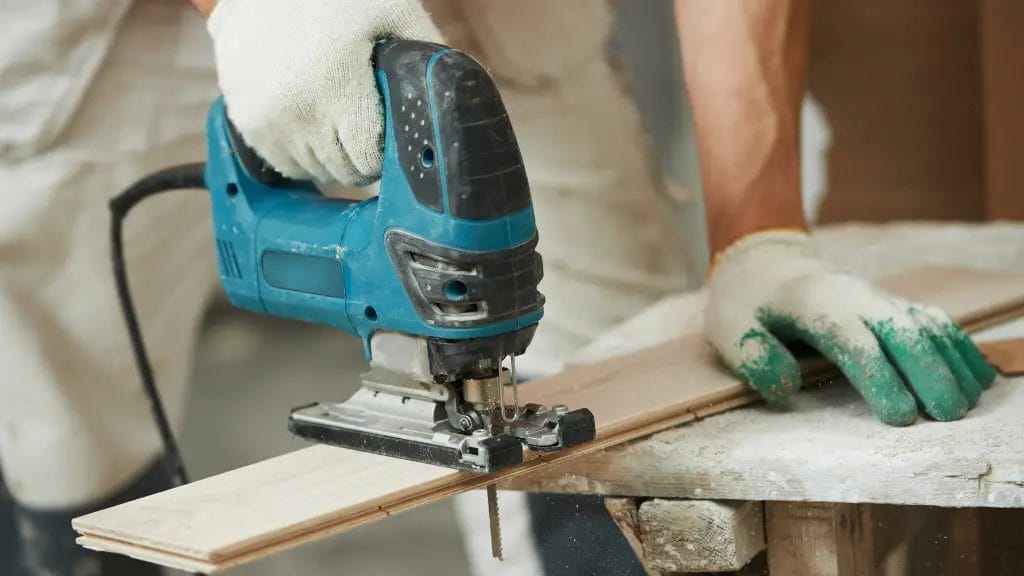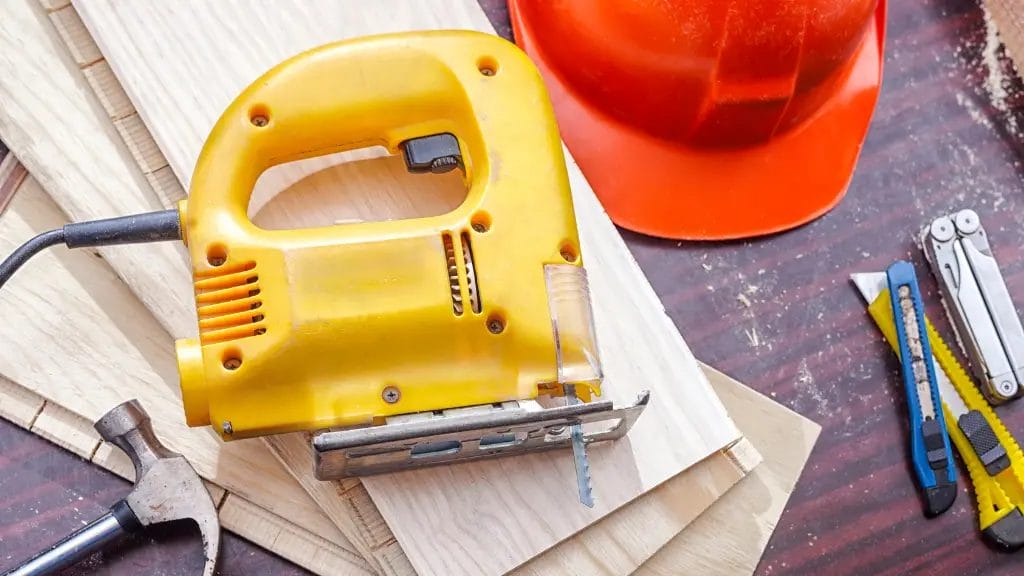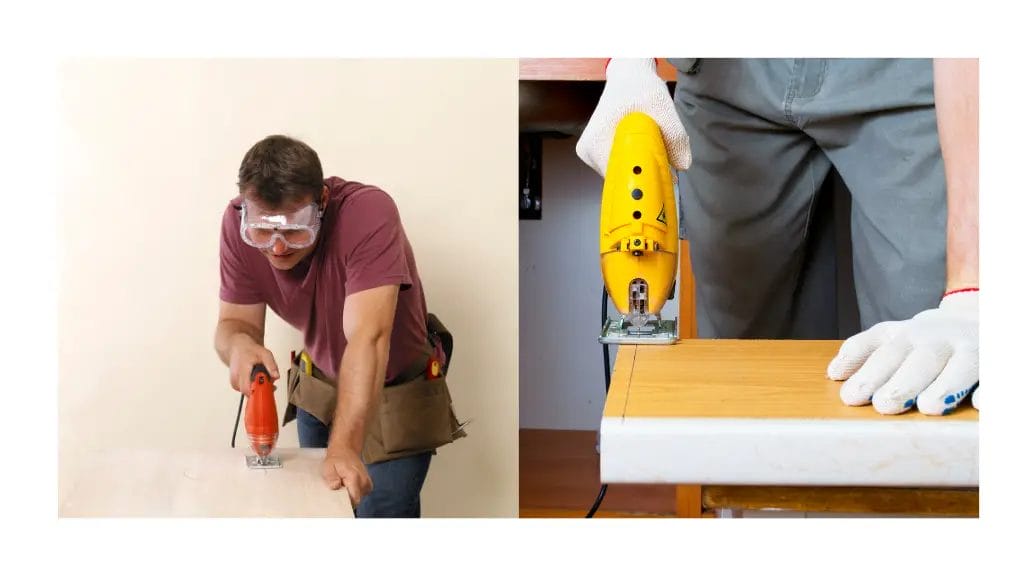
After you have assembled your jigsaw, you will want to use it to cut a piece of wood. To do this, you will need to have the wood on a flat surface, and the cutting guide will help you get the wood in the right place.
Line up the cutting guide with the side of the wood you want to make the cut in, and center the wheels on the line.
Make sure the wheels are under the cutting bit, or the guide will not work.
Get to Know Your Jigsaw
The jigsaw has been around for about four centuries, but it is still the most versatile type of saw, and one of the most common ways to cut wood.

When it comes to cutting curves, a jigsaw has no rival. Though a jigsaw can’t handle hardwoods or metal, it is a tool that every serious DIYer needs in his or her toolbox.
A jigsaw is one of the most versatile power tools you can have in your garage. Capable of cutting numerous different materials, you can tackle a wide range of DIY jobs with a jigsaw.
From wood and metal to plaster, a jigsaw can do it all.
But before you start cutting, you need to learn how to use this powerful tool correctly.
Finding the right jigsaw blade for the job is key to getting the job done right. The blade’s size and shape determine’s whether it will be used for rough cutting or fine cutting.
A larger blade, for example, is perfect for cutting through a thick piece of wood, while a smaller blade may be required for cutting intricate patterns or detailed cuts.
Set your saw’s cutting settings
When you are cutting wood, the first thing you need to do is to select the right jigsaw blade that will be capable of cutting the type of wood you will be working with.

A typical jigsaw blade is made up of three parts — the tooth, the gullet, and the hook. The tooth is the pointy bit that does the cutting.
A jigsaw blade has the highest number of teeth at its center, and it gradually reduces the number of teeth until it reaches the gullet.
The hook is a chisel-like blade that can be used for cutting hard materials like metal. For a jigsaw blade to perform the best, it must have the right teeth and gullet.
Blade & Jigsaw Basics
A power saw is a tool that can make your DIY jobs easier, but there’s more to it than you might think. If you’re new to power tools, you’ll want to learn some safety basics.
But, even if you’ve been using power tools for years, you still need to learn a few things.
You may know how to do things like using a table saw, drill, and nail gun, but you might not know the finer points of using them.
Here we’ll show you how to take care of your power tools, how to use them safely, and how to use them to do complex DIY projects.
Jigsaw Safety tips

Woodworking tools are dangerous, and you should always take proper precautions when using them.
Always wear safety goggles and make sure the work area is properly ventilated to avoid inhaling wood dust and other debris.
Also, make sure you have a working fire extinguisher nearby, just in case your workpiece starts to burn.
- Never wear loose clothing when working with a jigsaw, as loose clothing increases your chances of getting caught in moving blades. Instead, wear a pair of close-fitting pants that cover your ankles.
- Ensure that your work surface is stable and secure, and try to pick a work area that is well-lit and free of any tripping hazards.
Jigsaws are powerful machines, but they’re also fairly simple to operate. You just need to know what to do and what not to do.
The key to safe jigsaw operation is to focus on safety.
Jigsaws can produce powerful vibrations, and they can suddenly turn on, so you must take special precautions to protect yourself.
It’s also important to use the right blade for the job.
The advantage of using a Jigsaw
In carpentry, a jigsaw is a power saw which uses a small blade in the form of a narrow cutting disk called a jig blade to cut irregular or curved shapes in wood, plastic, metal, and other materials.
The jigsaw blade comes in many sizes and shapes and can be made of high-speed steel, cermet, or diamond.
The thin blade allows deep cuts to be made without much effort.
A jigsaw is an important tool, especially in woodwork where it often replaces a band saw or a circular saw.
It can be used for cutting curves where a circular saw cannot easily cut.
It is also often used to cut curves in thin metals, including aluminum. Setting up a jigsaw is very easy.
Tips for Using a Jigsaw
A jigsaw is a specialized saw that cuts curves and shapes, rather than straight lines.
The first step to using one is to mark the cut line. A cutting guide is an important accessory to use with a jigsaw.
The cutting guide attaches to the jigsaw and allows you to draw a line for cutting. If you don’t have a cutting guide, you can use a piece of graph paper or a taped line on the board.
The jigsaw will follow the line and help you to cut the line.
You can do this by using a pencil and a ruler, or you can use a special tool called a scribing tool that lets you draw the line without marking up the workpiece.
Once you have the line marked, it’s time to secure the workpiece. You can do this by clamping it to a workpiece or a workbench, or by using a vise or clamp.
Most jigsaws have a built-in vise that holds the workpiece in place while you’re cutting.
Finally, it’s time to fire up the jigsaw and make your cut.
In Conclusion

Jigsaws are great tools for woodworkers and hobbyists to use to accurately cut intricate shapes into a board. When you’re working with power tools, safety is always of paramount importance. Proper hand protection is crucial to safely use a jigsaw and prevent injury.
Jigsaw is one of the power tools that can cut a variety of materials. You just need to choose the right blade that can cut the material you are working with.
